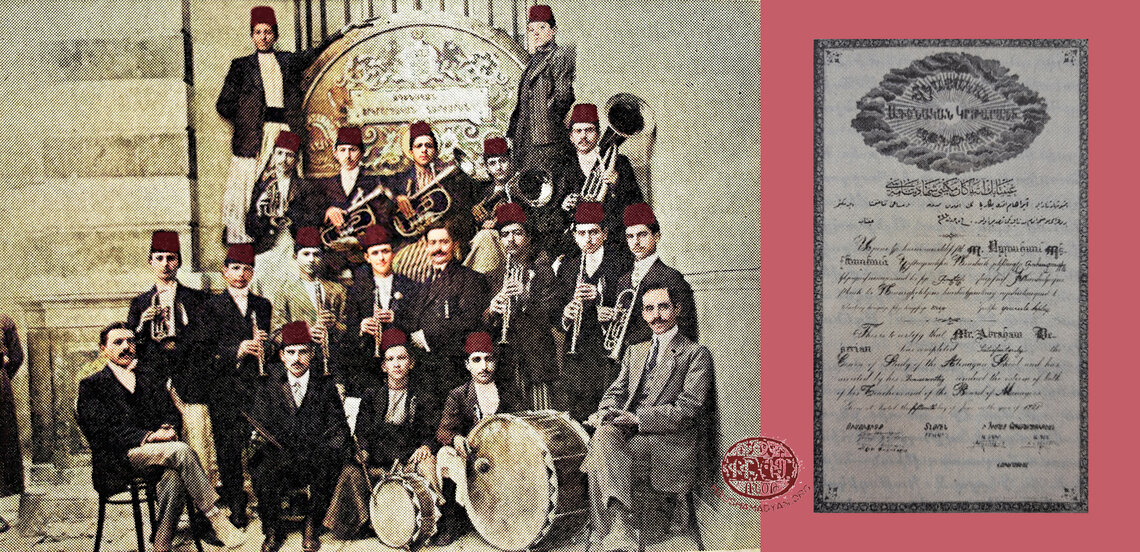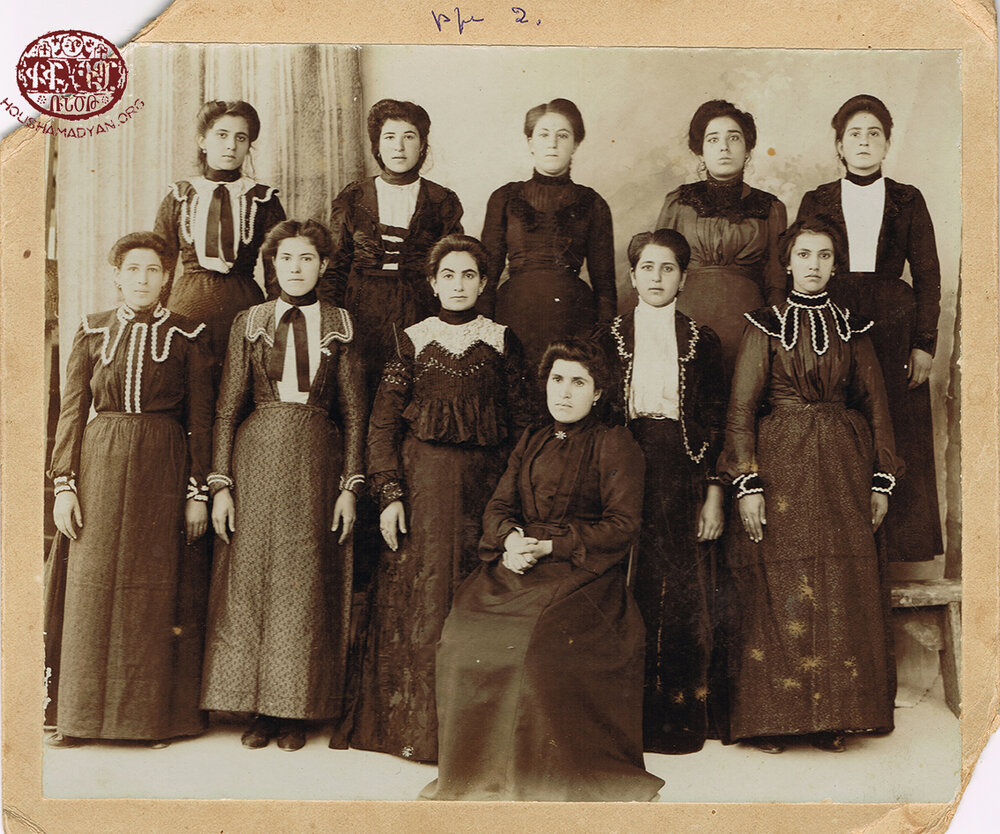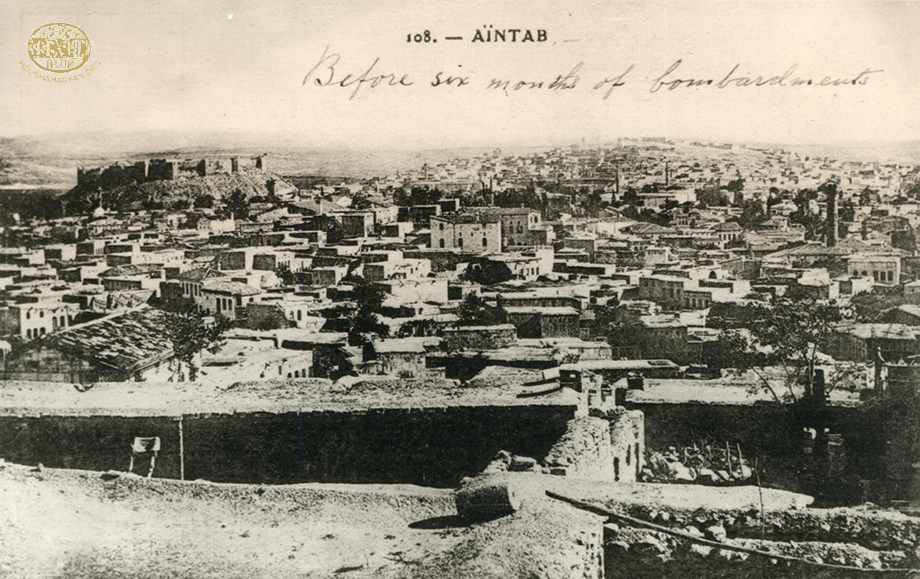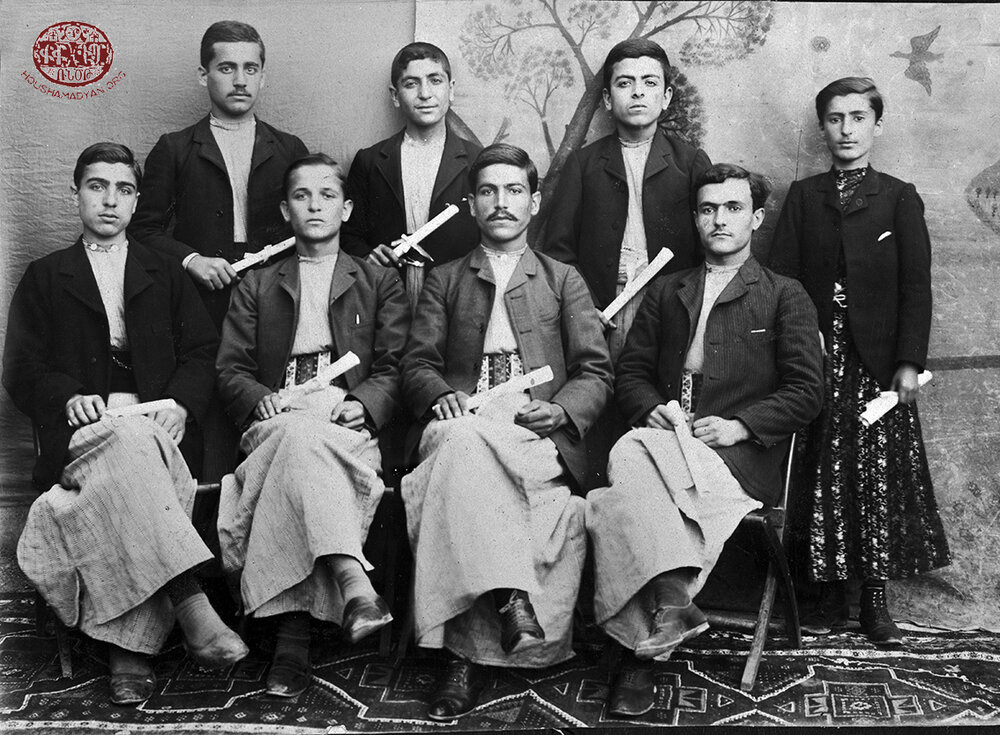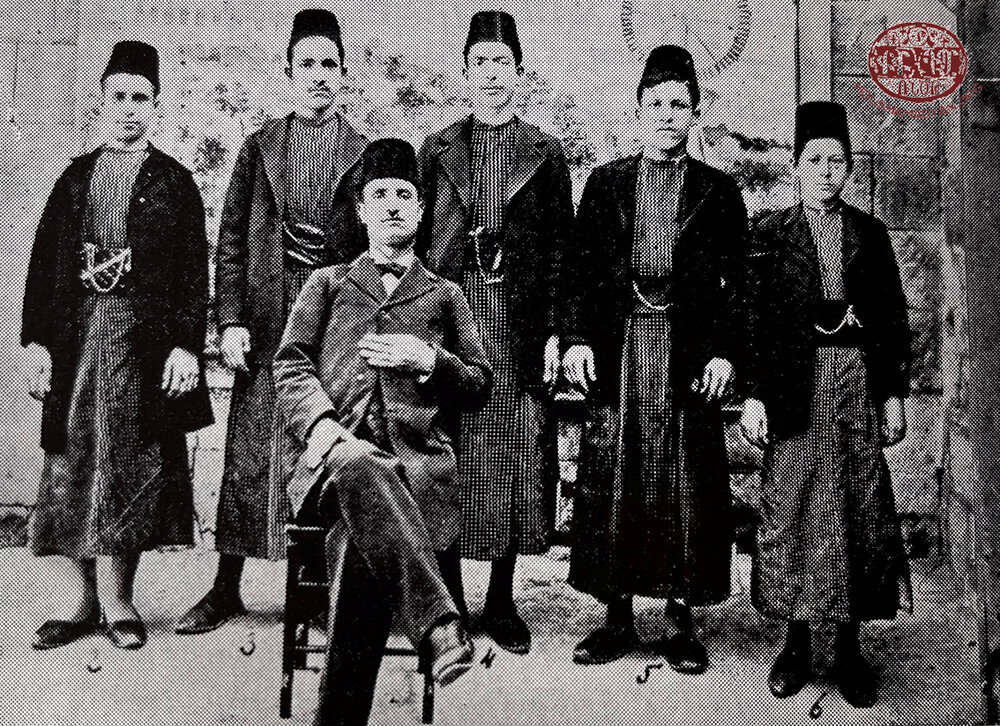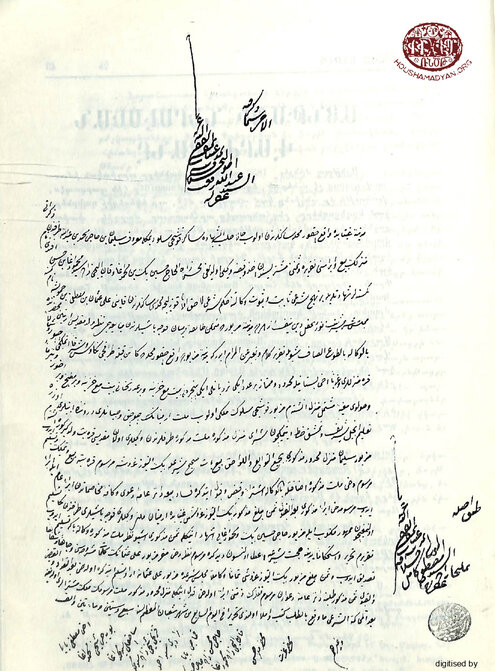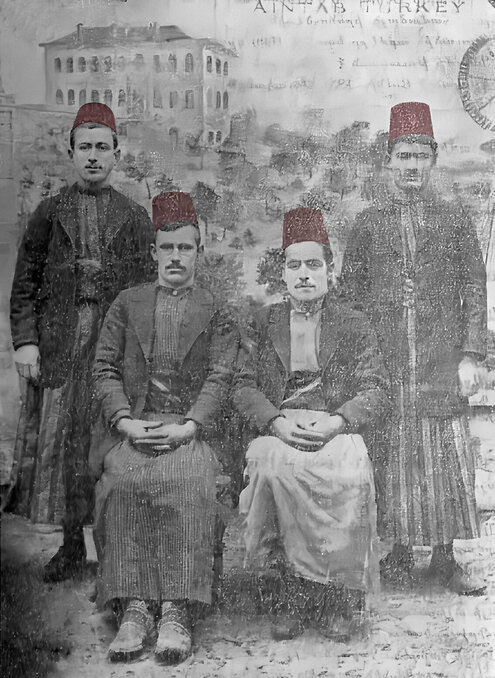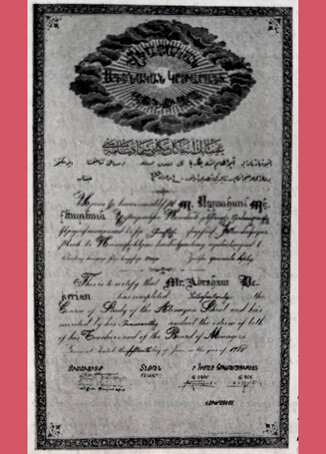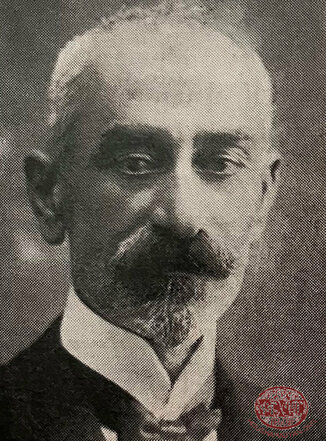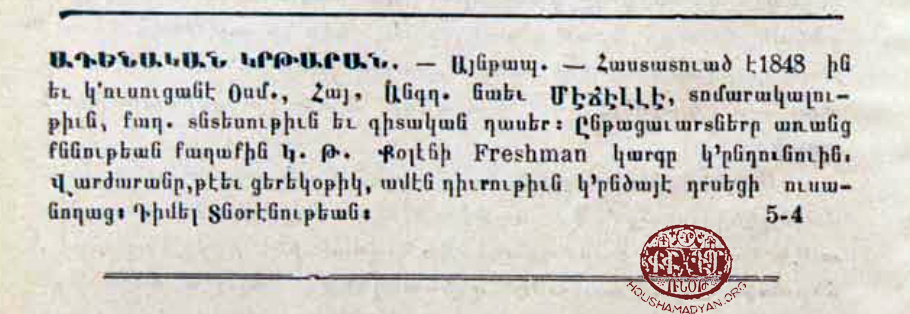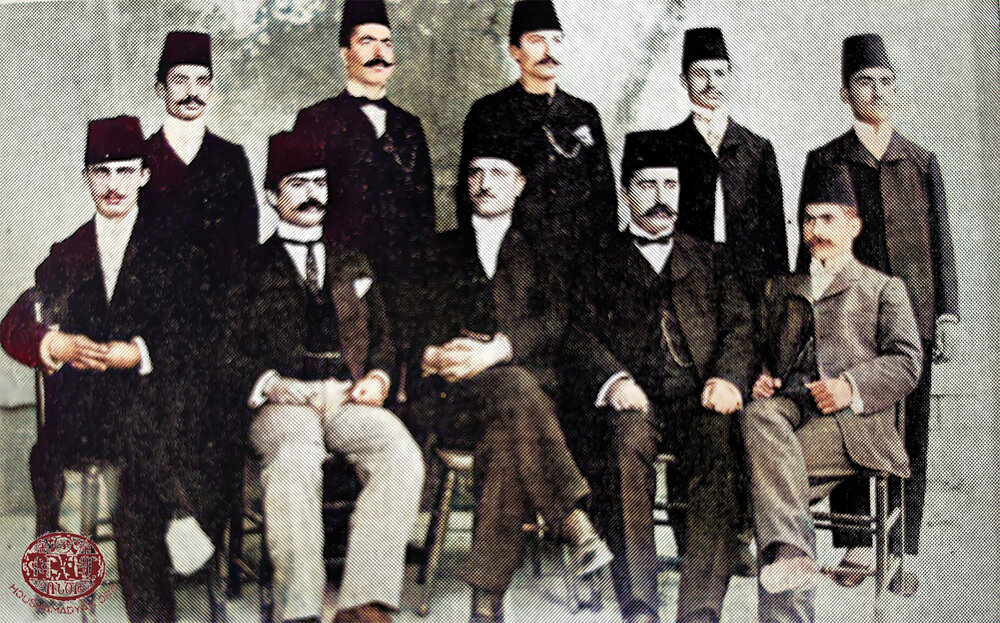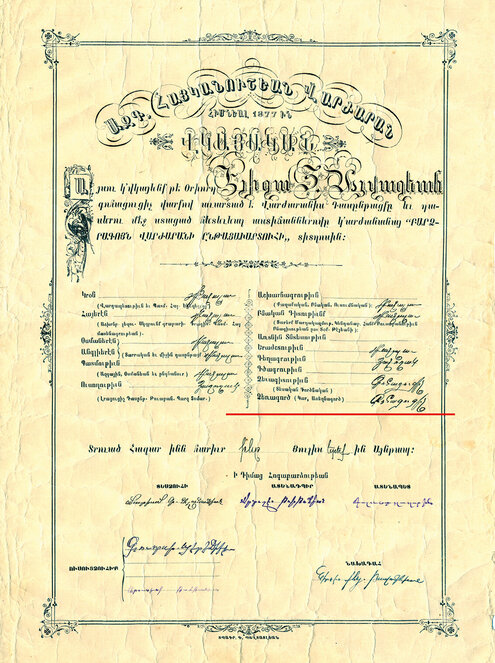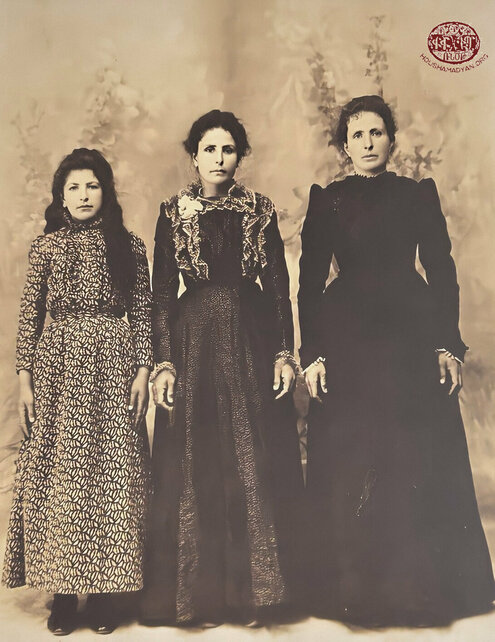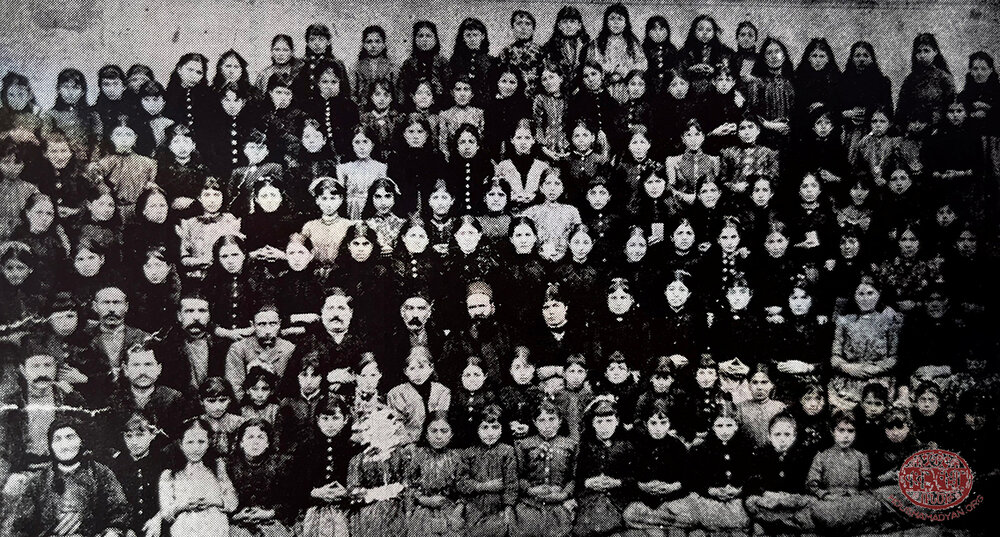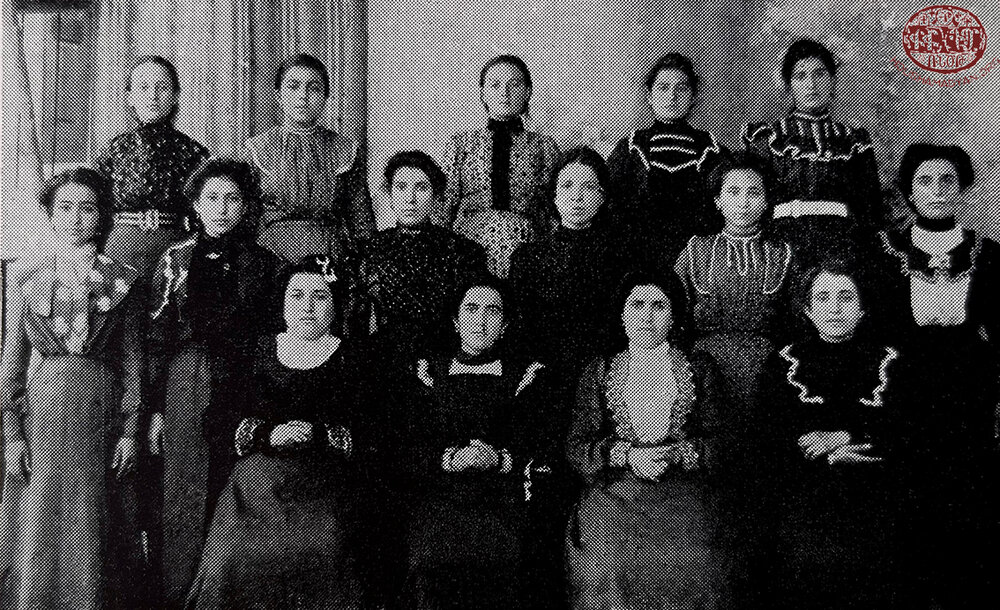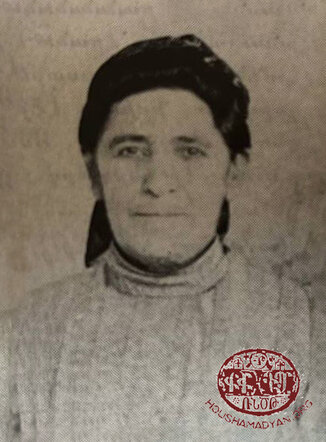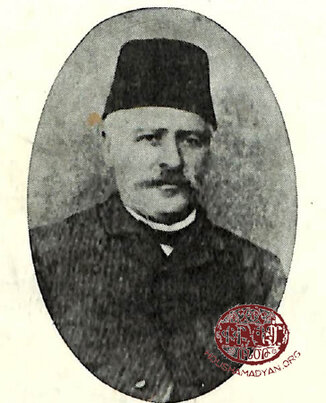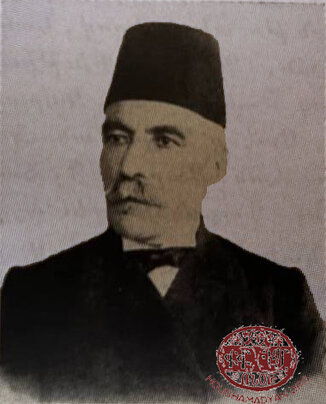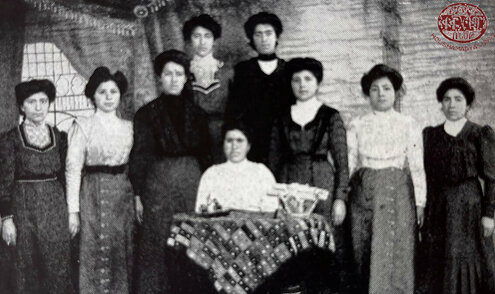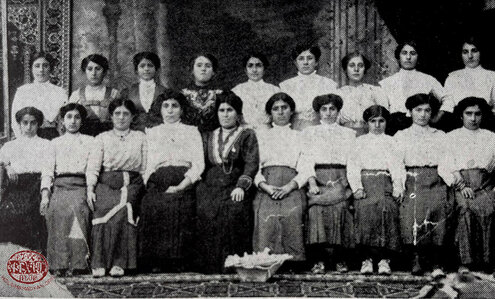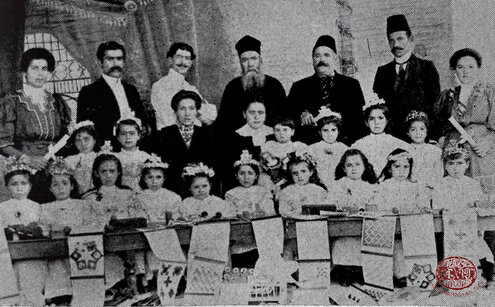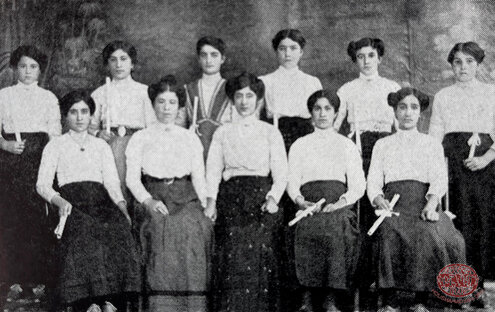Ayntab – Schools (Part One)
Author: Ani Voskanyan, 26/03/24 (Last modified 26/03/24) - Translator: Simon Beugekian

The 19th century was a formative era for the Armenian educational system in Ayntab. Especially in the second half of this century, the many Armenian educational institutions that were established and thrived in Ayntab not only stimulated all aspects of the community’s life, but also became a basic and essential condition for the community’s advancement and development.
The first boys’ school in Ayntab was opened in 1815-1817, and the first girls’ school was opened in 1860. [1] According to Professor Alexan Bezdjian’s figures, in 1912, the Armenian community of Ayntab was served by a total of approximately 32 schools, which employed 100 teachers of both sexes, and with a total enrollment of 3,175 pupils of both sexes. Ayntab was also home to the Central Turkey College, which had an enrollment of 244 pupils (including 12 Muslims); the American Girls’ Secondary School, with an enrollment of 155; and the orphanage run by Miss Frierson, an Englishwoman, which had an enrollment of 250 orphans of both sexes. [2] According to Artoun Hadidian, the number of Armenian schools in Ayntab was 17 in 1913, with a total enrollment of 2,600 pupils. Ayntab’s leading Armenian schools included the parochial Nersesian School, the Cilicia Boarding School, the Atenagan School, the Vartanian School, the parochial Haigazian School, the Hripsimyants School, the Haiganoushian School, the Cilician Lyceum, and many other educational institutions. [3]
The first volume of the Vidjagatsouyts Kavaragan Azkayin Varjaranats Tourkyo [Survey of Provincial Parochial Schools in Turkey], published in 1901, provides a comprehensive overview of Ayntab’s educational institutions and their financial situation. Based on the information in this survey, in 1901, there were ten operational Armenian educational institutions in the entire province of Ayntab, of which seven schools and one orphanage were located in the city of Ayntab, one school in the village of Oroul, and one school in the village of Kilis. [4]
Of the seven schools operating in the city of Ayntab in 1901, the Nersesian School had an enrollment of 400 boys and a faculty of 11 male teachers. The school’s monthly expenses totaled 1,750 kurus. The Vartanian School had an enrollment of 179 pupils, of whom 171 were boys and eight were girls. Its faculty also consisted of 11 teachers, three of whom were female. The school’s monthly costs totaled 1,250 kurus. The Atenagan School had an enrollment of 160 pupils and a faculty of six teachers, all male, and its monthly expenses totaled 1,620 kurus. Enrollment at the Haigazian School stood at 100 boys, with a faculty of three teachers (two male and one female), and monthly costs totaling 470 kurus. The Haiganoushian School had an enrollment of 470 female pupils and a faculty of 14 female teachers, with monthly costs of 2,000 kurus – higher than any other school in Ayntab in 1901. The Hripsimyants School had an enrollment of 150 girls and a faculty of four female teachers. Its monthly expenses totaled 400 kurus. The Grtasirats School had an enrollment of 75 female pupils, a faculty of five female teachers, and monthly costs totaling 300 kurus. The Ayntab Orphanage was home to 38 boys, had three staff members, and its monthly costs totaled 560 kurus. The Mesrobian private school also operated in Ayntab, with an enrollment of 100 pupils and a faculty of four teachers.
The S. Sahagian School was located in the village of Oroul. It had an enrollment of 34 pupils, of whom 29 were boys and 5 were girls. The school employed one teacher, and its yearly costs totaled 200 kurus, of which 100 kurus was provided by the village church. [5]
Papgen A. Guleserian, coadjutor to the Catholicos of the Holy See of Cilicia, wrote that he was unable to precisely ascertain when organized education first became available to the Armenians of Ayntab. On the western side of the roof of the old Armenian church in Ayntab, there was a structure that had once served as a school, known as the “Veri” [“Upper”] School. Across the street was the Nersesian School, also known as the “Vari” [“Lower”] School. [6] The headmaster of the Veri School was Father Movses Jamgochian (known as Teacher Avedik while still a layman). Later, the Haiganoushian School moved into this church building. [7]
The first formal school in Ayntab was founded in the second half of the 17th century. An acolyte by the name of Amirkhan, who had attended the schoolhouse of Aleppo, upon his return to Ayntab opened this schoolhouse in a building adjacent to the Holy Mother of God Church. Acolyte Amirkhan’s work was continued by Senior Priest Baghdasar. Records from the 18th century mention an acolyte named Saghatel Hagopian. Schools run by “acolytes” and “preachers” were succeeded by schools run by “khalfes” and “teachers/schoolmasters.” [8]

The Schoolhouse of the Teachers Apraham and Mourad
Between 1815(?) and 1830, two teachers, by the name of Apraham and Mourad (Haroutyun), ran their own schoolhouse in Ayntab. The two men, who were father and son, were natives of Aleppo. After settling in Ayntab, they founded a schoolhouse called Unt Hovanya S. Asdvadzadzni (“Under the Protection of the Mother of God”). This school lay the foundation for the modern Armenian educational system in Ayntab. [9]
Many of the pupils who were taught by Apraham and Mourad later went on to have their own careers in education. These included seven head khalfes, as well as assistants, who were employed by parochial schools or operated their own schools in their homes or sometimes even in shops. Four among these were particularly well-known. Hafuz (blind) Kevork Khalfe (Doctor Kevork Arslanian’s father) had his own schoolhouse, with an enrollment of 30 pupils. Mahseredjian Hagopdjan Khalfe was also a teacher, as well as a painter and a celebrated singer. Records also mention Boghos Khalfe, Kradjian Hagopdjan Khalfe, and other notable pupils of Apraham and Mourad. [10]

The Parochial Nersesian School (1856-1915)
In 1856, the first regular educational institution to operate in Ayntab, the parochial Nersesian School, was founded. It was named in honor of Nerses Shnorhali (Nerses the Gracious). The school continued operating until 1915.
The project began with the purchase of a plot of land worth 1,600 kurus in the Chokour neighborhood of the city. The two-floor school building was then constructed, consisting of a large hall and seven rooms. These efforts were supported by Nigoghos Nazaretian, son of the renowned Nazar Agha, as well as Deacon Hovsep Ashdjian. As enrollment grew, in 1870, a ground-level hall with a capacity of 500 was built. The school abutted a large playground, a grove of trees, and a garden. [11]
The parochial Nersesian School operated as a primary school with a kindergarten. [12] The school was overseen by a board of trustees appointed by the National Committee. Until the 1880s, children from all social classes attended the Nersesian School. Thereafter, after the opening of the Vartanian and Atenagan schools, only poorer students were left in the Nersesian School. Sources note that enrollment at the Nersesian School never fell below 400.
The parochial Nersesian School was funded by the proceeds of the Millet Khan, which belonged collectively to the city’s Armenian community. Two-thirds of the khan’s revenues were allocated to the school. [13]
The school’s curriculum differed from the curricula of the city’s khalfe schools. In addition to the traditional subjects of reading, grammar, logic, Bible studies, and liturgical singing, the school also taught Armenian history, mathematics, and penmanship. In 1886, the school also started teaching translation of modern Armenian, Ottoman grammar, and geography. In the first ten years of the school’s existence, the faculty still consisted of traditional khalfe teachers, including Teacher Kurlangudj Haroutyun, Teacher Minas Babayan (who was also the school’s general caretaker), Teacher Haroutyun Geovshenian, Teacher Cholak Haroutyun Beoshgezenian, and others. In 1886, two teachers were invited from Constantinople to serve at the school: Mardiros Sinanian, who served as a supervisor; and Teacher Khachig, who served as the singing coach and choirmaster. In that year, two of the school’s graduates were sent to Jerusalem, to continue their studies at the Jarankavorats School. In 1868, Garoudj Levonian became principal of the school. Among his students were Haroutyun Hadidian (Teacher Arshag), Kasbar Pilavdjian, Garabed Balian, and others. In 1870, the faculty of the Nersesian School included Khachadour Effendi, a teacher from Sebastia, whose assistants included the teachers Haroutyun Hadidian (mentioned above) and Teacher Haroutyun Geovshenian. [14] In 1871, Neses Baghdasarian (Teacher Armenag) became principal. During his term, drawing was added as a subject to the school’s curriculum.
In later years, Melkon Manougian served as principal of the school. Two newly ordained priests joined the faculty – Father Movses Jamgochian and Father Yeghishe Kilislian. Among the faculty of the primary school were Haroutyun Yessayan, Khachadour Bogharian, and Hagop Terzibashian. The kindergarten teachers included Kevork Mughurblian and Kaladju Melkonian Apoy Khalfe. During this period, principals of the school included Hovhannes Kurkdjianoff and Nigoghos Nazaretian. The Nersesian School experienced a period of growth in the 1870s. [15] In later years, this school, with its faculty constantly in flux, was not only able to withstand competition from newer schools, but also left an indelible mark on the history of Armenian education in Ayntab.
In 1965, the periodical Hay Ayntab [Armenian Ayntab] published photocopies of the purchase and sale document (ilam or houdjjet) of the property that housed the Nersesian School, alongside a translation of the document. [16]
- In the past, the neighborhood had been called Cokur Mahalle, which is the origin of the name Cokur Bostan.
- The property was purchased from Suleiman Bin Hadji Mouhammad bin Abdallah, a resident of Aleppo, whose representatives in Ayntab were Mouhsi Zade el Hadj Hussein Bey Bin Mouhammad Agha and Kan Aludju Zade Seyd Mahmoud Agha bin Hussein.
- The property included a house described as “mumtaz” (“excellent”), with double “nurbeden” (staircases), two windows, a “khazine” (storeroom) and kitchen, a cellar, and a barn on the ground level.
- The official buyer was Mahdesi Garabed, son of Krikor; and the transaction was witnessed by a “kodjabash” (notable) of the “tai’ifei Ermeni” (“Armenian community), mubay’yadju (gold and silver trader) Mahdesi Artin, son of Nazar.
- The property was purchased with the goal of teaching the “Enjili Sherif” (“the Holy Testament”) and literacy to “millet Armenian” [“Armenian children”], as prescribed by “Armenian custom.”
- The purchase price of the property was 1,600 kurus.
- The date of the purchase was 7 Sha’aban, 1267, of the Hijra calendar, which corresponds to July 7, 1851, of the Gregorian calendar.

The Tankaran [Museum] Society’s Night School (1858-1867)
In 1858, Khachadour Bogharian, Krikor Guleserian, and Kevork agha Sulahian (who was still a layman at the time) founded the first Armenian trusteeship (society) in Ayntab, called the Martasiragan [Humanitarian] Society. Upon joining the organization, Hovhannes Kurkdjianoff breathed new life into its activities, by organizing and regulating them. [17]
One of the main aims of the Martasiragan Society was to teach reading and writing to working youth and adults. The society founded a “night school,” which operated three nights a week, and provided instruction to cohorts of 12 or 24 students. The organization’s steady growth led to its reorganization and expansion. In 1860, it was renamed the Ousoumnasirats Tankaran [Scholastic Museum] Society. In 1862, it opened the first library/book repository in Ayntab (at the time, it was called a museum, from which the organization took its name). Deacon Hovsep Ashdjian donated the books he had brought from Jerusalem to this newly founded library, which later became the Vartanian Library. It was one of the largest libraries/book repositories in Ayntab, with a collection of more than 1,000 volumes. [18]
Building on the crucial work of its night school and library, the organization also launched a Sunday lecture series. The Ousoumnasirats Tankaran Society’s main sources of income were the donations collected during church services and Sunday lectures. [19] Already by 1867, on the advice of Krikor Apartian and Hovhannes Kurkdjianoff, the organization began planning to build a girls’ school in Ayntab. [20] The society also operated a primary school, called Mesrobian Sanouts, from 1874 to 1878. The school closed down due to financial difficulties. [21]
On December 15, 1864, on the initiative of Armenian prelate of Ayntab, Mgrdich Srpazan, and in collaboration with prominent local Armenians and the Ayntab Neighborhood Council, a summit was convened, which founded the Sahmanatragan Ousoumnaser [Constitutional Scholastic] Society. [22]

The Atenagan School (Orphanage/School in 1885-1886, Secondary School from 1886 to 1915)
Vahan Kurkdjian, Berdj-Nazaret Nersesian, and Hrand-Rafayel Minasian (Tertsagian), “junior” wards of the Cilicia Boarding School, founded the Yetemian Society in 1874, with the aim of “serving the welfare of the Armenian nation.” The founders also intended to establish a printing press. [23]
A short time later, the organization was renamed the Atinagan or Atenagan Society. The new name included the same Hebrew root word for “Eden.” Principal N. Terzian and Teacher Minas Babayan took this new organization under their wing. [24]
The Atenagan Society of Ayntab operated very successfully, both as an educational and a philanthropic/orphans’ care organization.
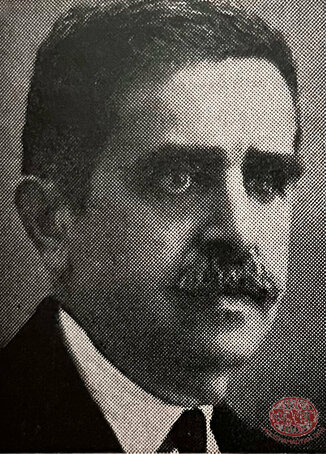
The executive board of the Atenagan Society consisted of 36 members, including Nerses G. Parseghian, Nerses S. Parseghian, Dikran Sahagian, Haroutyun Aseyan, Garoudj Terzibashian, Manoug Baghdoyan, Hagopdjan Baboyan, Krikor Daghulian, Smpad (Father Mesrob) Demirdjian, Sarkis Grboyan, Kevork Daghlian, Kevork Mughurblian (Father Garabed), Sarkis (Moushegh) Sarafian, the Very Reverend Garabed Baluyan, Hagop Chekichian, Sarkis Kradjian, Avedis Djebedjian, Krikor Basmadjian, Kasbar Beredjiglian, Krikor Leylegian, Haroutyun Kolandjian, Dr. Sarkis Hekimian, Haroutyun (Papken) Beoshgezenian, and others. [25]
The Atenagan Society experienced a period of rapid growth between 1882 and 1884, and was able to purchase property for its school. Initially, only a quarter of the land was purchased, then the full plot within six years. The society’s orphanage, which operated in Hasirli Doua Yeri, was relocated to this new location, and in 1885 began operating as a combined orphanage and school, with resident boarding students. A short time later, under the leadership of principal Hagop Bekyarian, the institution became the Atenagan School, though it still provided shelter to a number of orphans. After the massacres of 1896, the organization was also allowed to use the rooms of the Old Gate as shelters.
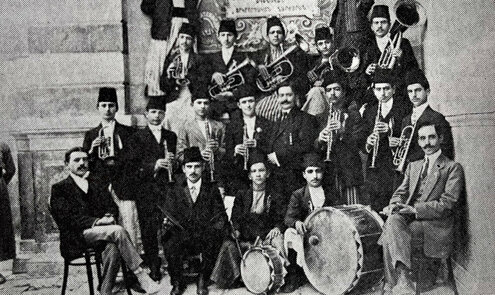
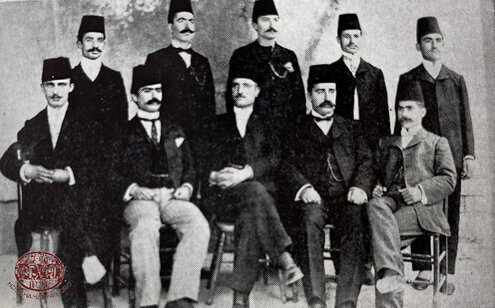
The Atenagan School had a kindergarten, primary school, and an upper school; and hosted a Sunday lecture series. The school followed the educational plan formulate by the Educational Council of Constantinople [26], except that it replaced French with English.
The school’s board of trustees and board of supervisors included the best and brightest of the Armenian intellectual and commercial classes of Ayntab. Aside from those already mentioned above, they included Hagop Karamanougian, Garoudj Merdjenian, Hovsep Arakelian, Haroutyun Kradjian, Hovsep Ashdjian, Krikor Aseyan, the Very Reverend Haroutyun Basmadjian, Melkon Kabakian, Garabed Karghayan, and others. [27] In 1885, the Atenagan Orphanage/School was home to 15 orphans. [28] The newspaper Yergrakound of Constantinople reported in 1887 that the Atenagan School was living up to its name and its charitable mission, as it provided free shelter and education to approximately 20 orphans. [29]
The first graduates of the Atenagan School received their diplomas in 1892. The graduates were Armenag Feredjian, Karekin Tutundjian, Tatoul Djzdrigian, Hrand Djanigian, Moushegh Hadidian, Nshan Bedrosian, Hagop Avakpanosian, and Smpad Der Boghosian. [30]
Over the years, the Atenagan School gradually grew from a six-year primary school (with a separate kindergarten) to a nine-year primary and upper school. [31]. In 1906, the Puragn newspaper of Constantinople advertised the school and encouraged families to send their children to it. The advertisement mentioned that the school taught Ottoman Turkish, Armenian, English, bookkeeping, home economics, etc. Graduates of the school were automatically accepted, without the need for an entrance examination, as freshmen (first course students) into the College of Central Turkey (an American missionary institution). The advertisement also mentioned that although the Atenagan operated as a day school, all accommodations were made for pupils who came from faraway regions. [32]
In 1911, with the approval and certification of the Ottoman Ministry of Education, the Atenagan became a seven-year secondary institution, producing its first secondary graduating class in 1913. During the term of the school’s last principal, Hagop Zeytountsian (1913-1915), more subjects were taught in English, including accounting, geometry, biology, physical sciences, etc. Special provisions were also made to teach French. It was thanks to these changes that graduates of the school could enroll in the Central Turkey College without the need for an entrance examination.
The Atenagan School was the only school in Ayntab that had its own marching band [33].
In his edict numbered 293 and issued on October 24, 1913, Catholicos Sahag II Khabarian bestowed his special pastoral blessing on the Atenagan School. [34] This school-orphanage, which had begun operating in the late 19th century with just two dozen wards, had become a fully-fledged secondary school and produced 97 graduates between 1892 and 1913. [35] In the 1913-1914 academic year, enrollment at the school reached 288. [36] By 1915, the Atenagan School was operating as a certified secondary school and had an enrollment of 300 pupils. [37]
With the increase in enrollment came the need for a larger building. Thanks to the efforts of Sarkis Kradjian, a member of the school’s board of trustees and a steadfast supporter of Armenian education, a property measuring 10,000 gankoun was purchased outside the city, with the aim of relocating the school to that site. [38]
However, until the purchase of this large property was finalized, the Atenagan School operated on rented premises in the Kastel Pashi neighborhood, at the site of the former Haserli School (later, this building became the Niziblian Museum). In 1890, the school moved into a building in the church neighborhood that had several rooms and a courtyard, and where a large hall was also built. In 1906, a fire burned down the classrooms, but immediately, eight shops were built, and above them, to house the school, six classrooms and a hall. In 1911, an adjacent building was purchased. [39]
The main sources of income for the Atenagan School were:
- - Tuition fees paid by the students.
- - Proceeds from the Sunday lecture series.
- - Rent from the eight shops.
- - Proceeds from events and performances.
- - Yearly dues paid by members of the Atenagan Society.
- - Proceeds from a barber shop.
- - Donations on the occasions of weddings, baptisms, and funerals. [40]

The Parochial Haigazian School
The parochial Haigazian Society, like some of the other educational and scholastic organizations active in Ayntab, operated a museum/library and offered night classes and Sunday lectures. Among the society’s founders was Hagop Karamanougian (Keordjemian), a long-time trustee and custodian of the future Haigazian School. He created the organization alongside like-minded Armenians from the Rahan Sokagh [41] neighborhood. [42]
In 1884, the society founded the parochial Haigazian School. According to Senior Priest Father Mesrob Keoshgerian, Mardiros Gedigian and two of his friends asked for donations from the prominent citizens of the Rahan Sokagh neighborhood, organized fundraising events among the city’s Armenians, and with the proceeds they raised, purchased a room suitable for schooling. Among the school’s founders, sources mention Mardiros Gedigian and his two friends (Father Keoshgerian did not know their names), as well as Chakmakdju Kevork, Oundjou Panos, Sheohmeli Artin, Keoshger Hagop, Djivan Kevork, Tumtumu Sarkis, Chouldjou Hovhannes, Djebedji Hagop, Deyirmendji Nerso, Kuludju Garoudj, and others, all from the Rahan neighborhood. [43]
In 1887, the school had an enrollment of approximately 30 pupils. Both the Haigazian Society and the school were supported steadfastly by Krikor Manoushagian and his patriotic friends. [44] At the end of the 1898-1899 school year, 11 students graduated from the Haigazian School. [45]
Krikor Bogharian mentions that the school lacked its own building until 1900, instead operating in the house of Ashuk Vartan. Later, the school moved into its own building that had a hall, four rooms, two courtyards, and a garden. Throughout these years, enrollment at the school never fell below 100. Haigazian did not offer full primary instruction. Sometimes, before even graduating, students would apply to the Nersesian, Atenagan, or Vartanian schools; as well as to the College of Central Turkey. The school reached its heyday in the years 1869-1902. [46] Among the school’s first teachers was Teacher Vrtanes, from Constantinople. [47]
The Haigazian School operated under the administration of the Armenian national/parochial authorities. It received funds from the revenues of Millet Khan. [48]

The Lousinian School
The Lousinian School was founded in 1909, on the initiative of the Christosasirats [Christ-Loving] Society of Ayntab. The project was led by Vahan Manna Tovmasian, the school’s future principal. The members of the board were Setrag Aladjadjian, Krikor Saatdjian, Krikor and Haroutyun Daghulian, Mihran Haladjian, Haroutyun B. Nazarian, and Vahan Tovmasian. The school’s first teachers were Nouritsa Mehseredjian and Eliza Ayvazian (Setrag Aladjadjian’s wife). They were later joined by Yeranig Sanosian (Mrs. Kourian). [49]
The school initially operated on rented premises, but within two years, it was able to acquire its own building. The home of Sebouh Chakmakdjian was purchased for 200 Ottoman pounds, and another 100 pounds was spent adapting the building into a school. The school’s courtyard and first-floor hall were used by the Christosasirats Society for its public meetings on Sundays. In its first year of operation, the school had an enrollment of 60 pupils, which doubled to more than 120 by 1913. [50]

Girls’ Schools
We know that the first girls’ schools in Ayntab were opened by Protestant missionaries. But alongside these missionary schools, until the establishment of the first regular girls’ school in the city, Teacher Varter Seferian-Kaymakamian [51] taught Armenian to girls in her home, gradually growing the number of her pupils. In the first 12 years of this home school, the number of pupils reached 20. Aside from academic classes, Varter Seferian-Kaymakamian also taught her pupils sewing, embroidery, and psalm singing. Varter’s work was noticed by Catholicos Mgrdich I Kefsizian. The Catholicos rented a room for the school and allocated it two mejidehs per month. He also appointed the blind teacher Gharlanguch (Dzidzernag) as an assistant to Teacher Varter. After some time, another female assistant joined the staff of the school. Enrollment reached 60, and younger girls were accepted. Catechism, geography, and mathematics were added to the school’s curriculum. [52]

The Parochial Haiganoushian School (1878-1915)
The success of a number of girls’ schools that operated in Constantinople, Smyrna, and other large centers of population; of the Armenian girls’ school founded by Hovhannes Kurkdjianoff in Aleppo in 1862; of the schools that were opened in Ayntab first by Protestant and later Catholic missionaries; and the progressive ideas that swept the country after the ratification of the National Constitution led to the opening of many girls’ schools in Ayntab in a short period of time. The Srpots Vartananats Tanakaran [Saint Vartanants Museum] Society already had plans to open a special girls’ school and had already secured the requisite funding. This plan was formulated by Hovhannes Kurkdjianoff and Nigoghos Nazaretian, as well as the Baghdasarian brothers, who had returned from Jerusalem in 1871, and knew of the Kayanian Girls’ School that operated in that city. [53]
After the closing of the Cilicia Boarding School in 1877, the Neighborhood Council, led by Nigoghos Nazaretian, decided to open the first girls’ school in Ayntab, housed in the former Cilicia Boarding School building, using its hall and three rooms. The parochial Haiganoushian School opened its doors on March 1, 1878. Its inaugural principal was Teacher Armenag Baghdasarian.
Mgrdich I Kefsizian, Catholicos of the Holy See of Cilicia, urged Armenian parents to send their daughters to school. Moreover, to encourage the Armenians of the city to educate their daughters, among the first students enrolled in the Haiganoushian School were Nigoghos Agha’s own daughters, Yeprouhi and Zmroukhd Nazaretian. In its first year, enrollment at the Haiganoushian School reached 120. The faculty included Teacher Hagopdjan Geovshenian and Teacher Horom Isgenderian. The rise in enrollment led to an increase in the number of teachers. The faculty was joined by Maryam Boghosian, Teacher Yeghsa, Hripsime Misirian, Maryam Baghdoyan, Hripsime Baghdasarian, and others. The school’s curriculum included reading, grammar, mathematics, catechism, Armenian history, drawing, penmanship, and embroidery. The curriculum was regularly reformed in line with the recommendations of the Educational Council of Constantinople. In later years, Turkish and English were added as subjects. [54] In 1889, the pupils of the school created the Untertsasirats [Book-Loving] Society, whose primary goal was to encourage and promote the love of reading among girls and women. [55]
The Haiganoushian School initially operated as a kindergarten, but over time, it grew to become a six-year primary school. The number of pupils eventually reached 500, with 300 of them enrolled in the kindergarten and 190-200 in the primary school. [56]
The kindergarten and primary school of the Haiganoushian School employed 12-13 permanent teachers each year, in addition to four visiting primary school teachers and two custodians. The wages paid to these employees totaled 8-9 Ottoman pounds per month. Each pricipal was paid about 10 pounds per month. The school’s teachers and employees received no pay during the two-month school holidays. [57]
The school’s kindergarten was housed in the Old Gate, on the northern side of the church courtyard. It included two classrooms and one hall. In 1893, after the construction of the new church, the old church was given to the Haiganoushian School to use as its kindergarten. The primary school was housed in the old, columned hall of the former Veri [Upper] School. In 1902, thanks to a donation by the philanthropist couple Kalousd Ghazarian and Lucia Nazaretian-Ghazarian, the school was able to renovate the hall and refurnish its classrooms. [58]
The Haiganoushian School’s budget relied on the proceeds of Millet Khan. [59] Additionally, from the day of its founding, the school received funds from the “National Hotel.” The rest of the school’s expenses were covered by the pupils’ tuition fees – rarely more than one-half an Ottoman Pound, and as low as 12.5 tahegan per year, per student. [60] The tuition fees made up an insignificant percentage of the institution’s yearly revenue, and few families paid these fees fully. Most paid one metalig per week, the equivalent of one mejideh per year. On New Year’s Day, the school held its yearly performance event, for which it sold tickets and held an embroidery raffle. Over the years, members of the school’s board of trustees included Nazaret Manoushagian, Hrand Sulahian, Krikor Kutugian, Armenag Baghdasarian, Kevork Topbashian, Garabed Yaghsuzian, Krikor Leylegian, Hagop Karamanougian, Ghazaros Ghbligian, Hagop Ghazarian, Sarkis B. Nazarian, Nazaret Fustukdjian, Movses Kazandjian, and others. [61]
Beginning in 1904, the Haiganoushian School had branches in Tabakkhane, Rahan Sokagh, and in other neighborhoods.
Throughout its years of operation, members of the school’s faculty included, aside from those already mentioned, Teacher Makrouhi Berberian, Teacher Nartouhi Nalbandian, Haiganoush Manoushagian, Dirouhi Bekarian, Ovsanna Meshefedjian, Arshaluys Aladjadjian, Arousyag Tahtadjian, Yeranig Kabbendjian, Azniv Israelian, Zarouhi Kechedjian, Mary, Santoukhd, the Eliza Ayvazian sisters, Santoukhd Asadourian, Siranoush Bilemdjian, and others. Many were graduates of the school. The school’s singing teacher was Teacher Kasbar Pilavdjian, and the upper classes were often taught catechism by visiting priests, with sources mentioning Father Mesrob and Father Nerses. [62]
Over the years, 281 students graduated from the Haiganoushian School. [63] Already in 1890, the Arevelk newspaper of Constantinople, reporting on the work of the “Girls’ Parochial School,” mentioned that the school provided a great service to the nation, and that its pupils had an excellent knowledge of Armenian and possessed analytical minds. [64]
In 1919, after the return of exiled Armenians to Ayntab, thanks to the efforts of the Ayntab National Society and its president, Father Nerses Tavoukdjian, the parochial Haiganoushian School was reopened. However, after the final exile of Armenians from Ayntab, in 1922, the school closed permanently. [65]
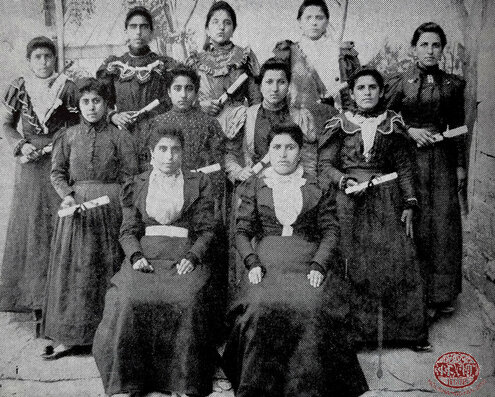
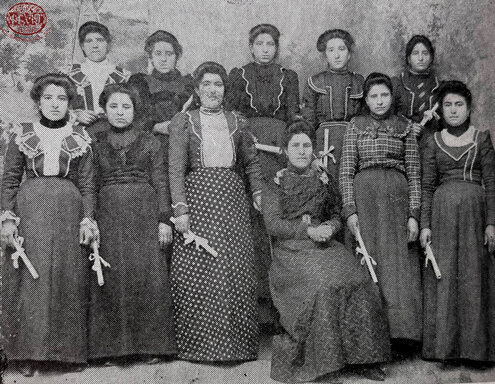

The Hripsimyants Schools (Primary School from 1890 to 1905; Kindergarten from 1905 to 1915)
In 1879, the principal of the parochial Haiganoushian School, teacher Armenag Baghdasarian, alongside a group of women who advocated for girls’ education, founded the first women’s organization in Ayntab, the Hripsimyants Barzasirats Society. The society’s president was Father Yeghishe Kilislian. The aim of the Hripmsimyants Society was to support the education of girls and female orphans, as well as to encourage them to choose a simpler lifestyle that shunned ostentation. [66]
The Hripsimyants Society had the support of the Ayntab Neighborhood Council, especially its chairman, Nigoghos Nazaretian, which contributed to the organization’s quick growth. Moreover, the personal example set by the members of the board of trustees, such as Feride Leylegian, Elmasd Kurkdjian, Lucia Nazaretian-Ghazarian, and Khanoum Leylegian, significantly contributed to the organization’s expansion.
In the 1890s, the organization acquired its own building in the Kastel Pashi neighborhood, where it established its girls’ primary school. The school continued to operate until 1905, although sometimes as a kindergarten. [67]
In 1887, the Hripmsimyants Barzasirats Society’s School had an enrollment of 150 pupils. [68] In 1888, in its ninth year of operation, the society had a membership of 300 women, who collectively oversaw the work of five schools with a total enrollment of 250 pupils. [69]
Until 1892, the Hripsimyants Society used all means at its disposal to support the Haiganoushian School, by paying the fees of 60 of its pupils. Aside from this scholarship program, the society also provided clothing to these girls. [70] In 1895, the Hripsimyants School became a kindergarten, and Rozig Tahmazian was appointed as its director. [71]
The Hripsimyants Society, like other educational societies, ran a Sunday lecture series, which was offered exclusively to women and was supervised by Teacher Armenag. Between 1919 and 1922, the Hripsimyants Kindergarten operated under the aegis of the National Committee. [72]

The Grtasirats School (1898-1915)
In 1896, a group of students led by Nazaret Ipekian, Dr. Yeghia Aroyan, Nouridjan Niziblian, and others founded a lecture hall in Ayntab to provide education to girls and women. The meetings took place on Sundays, in the hall of the old Haiganoushian School, and were attended exclusively by women. The meetings discussed religious/moral, educational, and health topics, under the aegis of the newly founded Ggherasirats Society. [73] However, the women attending these meetings soon decided to create their own organization, calling it the Grtasirats [Scholastic/Education-Loving] Society. The aim of this organization was to contribute to the education of girls, as well as to support the parochial Haiganoushian School. Among the women who led this initiative were Yepros Leylegian, Ovsanna Tosounian, M. Der Melkonian (a priest’s wife), Yevkine Pandjardjian, Nouridjan Niziblian, Haiganoush Manoushagian, and Zarouhi Karageozian. Their efforts were supported by the brothers Yusuf and Senekerim Niziblian, Apraham Seraydarian, Khachadour Khachadourian, Smpad Der Boghosian, and Manoug Pandjardjian. [74]
With proceeds from donations and public fundraising efforts, a special fund was created to rent and furnish a school building for the Grtasirats Society. In 1898, the Grtasirats School was founded, and became the second Armenian girls’ primary school to operate in Ayntab. The school’s first principal was Anitsa Sulahian (later the wife of Father Nerses Tavoukdjian). She was followed by Makrouhi Beredjiglian (1903-1908), then Araksia Djebedjian, Armenouhi Baghdoyan, and Koudsi Beredjiglian, each of whom served in this capacity for one year. From 1911 to 1915, the principal of the Grtasirats School was Hranoush Tahtadjian. [75]
Enrollment at the Grtasirats School was as high as 150 pupils. The school’s revenues came from tuition fees, donations collected during lectures, and a yearly embroidery raffle. The curriculum was similar to that of the Haiganoushian School, but the Grtasirats excelled in teaching Turkish and English, as shown by the successes of its 1912-1914 graduates. [76]
After the 1918 the Armistice of Mudros, from 1919 to 1922, the Grtasirats Schools was reopened and became part of the unified Armenian school network under the administration of the Armenian National Committee. The school was shuttered after the final exodus of Armenians from Ayntab. In 1924, the Grtasirats reopened in Aleppo, with a kindergarten and a boys’ and girls’ primary school. [77] The school continues to operate in Aleppo today, under the name of the S. Chemberdjian Grtasirats School.

- [1] Artoun Hadidian, “Armenian Ayntab and its Battle for Survival,” Etchmiadzin, Mother See of Holy Etchmiadzin, 1970, number 3, March, p. 22.
- [2] H. A. Bezdjian, “The Educational Situation in Ayntab: Past and Present,” Gochnag [Clarion], New York, 1912, number 13, March 30, pp. 306-307.
- [3] Artoun Hadidian, “Armenian Ayntab and its Battle for Survival,” p.22.
- [4] Vidjagatsouyts Kavaragan Azkayin Varjaranats Tourkyo [Survey of Provincial Parochial Schools in Turkey], volume 1, Constantinople, H. Madteosian Printing House, 1901, table number 25.
- [5] Ibid.
- [6] The institution was known as the “Lower School” (Aşağı Mektep) because it was located in the Su Burç (“Water Tower” or “Water Fountain”) area of the city (Archbishop Papken, “Notes on the Armenian History of Ayntab,” Badmoutyun Ayntabi Hayots [History of the Armenians of Ayntab] (hereafter known as BAH), volume 1, edited and compiled by Kevork A. Sarafian, Los Angeles, 1953, p. 16).
- [7] Ibid., pp. 16-17.
- [8] Krikor Bogharian, “Educational Life in Ayntab and the History of the Armenian Schools of Ayntab,” BAH, volume 1, pp. 638-640.
- [9] Ibid., p. 640.
- [10] Ibid., pp. 646-647.
- [11] Ibid., pp. 652-654.
- [12] Kindergartens or preliminary classes, also called sgsnag [introductory] classes, were for children between the ages of six and eight and offered two years of instruction. Then, children would move on to primary schools or upper schools, reserved for pupils between the ages of 9 and 16.
- [13] BAH, volume 1, pp. 658-659. Also see Vart, “The City of Ayntab,” Araks, Saint Petersburg, 1888, book 2, May, p. 60.
- [14] Krikor Bogharian, “Educational Life in Ayntab and the History of the Armenian Schools of Ayntab,” BAH, volume 1, p. 655.
- [15] Ibid., pp. 656-657.
- [16] K[rikor] Bogharian, “The Nersesian School of Ayntab,” Hay Ayntab [Armenian Ayntab], Beirut, 1965, n. 2, pp. 43-45.
- [17] Nazar [Armenag Nazaretian], “Societal Issues – the Tankarandju Crosses,” Puzantion [Byzantium], Constantinople, number 696, 1899, 30 January/12 February, p. 1.
- [18] Krikor Bogharian, “Educational Life in Ayntab and the History of the Armenian Schools of Ayntab,” BAH, volume 1, p. 660.
- [19] Ibid.
- [20] Nazar [Armenag Nazaretian], “Societal Issues – the Tankarandju Crosses,” Puzantion, Constantinople, number 696, 1899, 30 January/12 February, p. 1.
- [21] V. N. G. [Vahe Guleserian], “Vahan M. Kurkdjian and the Vartanants School,” Hay Ayntab, Beirut, number 5, 1962, p. 4.
- [22] Masis, Constantinople, number 676, 1865, 23 January, p. 3.
- [23] V[ahan] M. Kurkdjian, “Atenagan and Vartanian,” Hayasdani Gochnag [Clarion of Armenia], New York, number 38, 1928, 22 September, pp. 1195-1196.
- [24] Krikor Bogharian, “The Atenagan School,” BAH, volume 1, p. 740.
- [25] Ibid., pp. 740-741.
- [26] According to the stipulations of the Armenian National Constitution, the Educational Council was created to oversee and coordinate the Armenian national/parochial educational system (for details, see Azkayin Sahmanatroutyun Hayots [National Constitution of Armenians], Constantinople, 1860, pp. 16-17).
- [27] Krikor Bogharian, “The Atenagan School,” BAH, volume 1, pp. 742-743.
- [28] Hovhannes Araradian, “The Atenagan Central School of Ayntab,” BAH, volume 1, p. 749.
- [29] Father Ghevont Der Nahabedian, “The Provinces,” Yergrakound [Earth], Constantinople, 1887, number 3-4, March-April, p. 159.
- [30] Krikor Bogharian, “The Atenagan School,” BAH, volume 1, p. 743.
- [31] Hovhannes Araradian, “The Atenagan Central School of Ayntab,” BAH, volume 1, p. 749.
- [32] Puragn, Constantinople, 1906, number 28, August 5, last page.
- [33] Krikor Bogharian, “The Atenagan School,” BAH, volume 1, pp. 743-744.
- [34] Ibid., p. 744.
- [35] Hovhannes Araradian, “The Central Atenagan School of Ayntab,” BAH, volume 1, p. 752.
- [36] Krikor Bogharian, “The Atenagan School,” BAH, volume 1, p. 747.
- [37] Hovhannes Araradian, “The Central Atenagan School of Ayntab,” BAH, volume 1, p. 752.
- [38] Krikor Bogharian, “Sarkis Kradjian (1872-1929),” BAH, volume 2, p. 763.
- [39] Hovhannes Araradian, “The Central Atenagan School of Ayntab,” BAH, volume 1, pp. 751-752.
- [40] Ibid., p. 752.
- [41] The name was inspired by the large number of trees and flowers that adorned the neighborhood’s homes and gardens (BAH, volume 1, p. 737). The full name, Rahan Sokagh, can be translated into “neighborhood of flowers/trees.”
- [42] Krikor Bogharian, “The Parochial Haigazian School,” BAH, volume 1, p. 737.
- [43] Senior Priest Mesrob Keoshgerian, “The Parochial Haigazian School,” BAH, volume 1, p. 739.
- [44] Father Ghevont Der Nahabedian, “The Situation of Armenians in Ayntab,” Arevelyan Mamoul [Eastern Press], Smyrna, 1887, March, p. 100. Also see Father Ghevont Der Nahabedian, “The Provinces,” Yergrakound, Constantinople, number 3-4, 1887, March-April, p. 159.
- [45] Nazar [Armenag Nazaretian], “Cilician Chronicle,” Puzantion, Constantinople, number 851, 1899, 3/15 August, p. 1
- [46] Krikor Bogharian, “The Parochial Haigazian School,” BAH, volume 1, p. 738.
- [47] Ibid.
- [48] Krikor Bogharian, “The Parochial Haigazian School,” BAH, volume 1, p. 738.
- [49] Vahan Manna Tovmasian, “The Lousinian School,” BAH, volume 1, pp. 773-774.
- [50] Ibid., p. 774.
- [51] Varter Seferian-Kaymakamian was born in Ayntab, in 1835. She lost her parents at a young age and was raised by relatives. She had a great love for learning, and she would sneak into the Nersesian School (for boys) and listen to the lessons. With the help of her great aunt and Teacher Arisdages of the Nersesian School, she was admitted into the “boys’” school. Varter Seferian-Kaymakamian was deported in 1915 and perished in the desert (see “A Champion of the Education of Women,” BAH, volume 1, pp. 686-688).
- [52] Ibid.
- [53] Krikor Bogharian, “The Parochial Haiganoushian School,” BAH, volume 1, p. 690.
- [54] Ibid., pp. 690-692 and 695.
- [55] S. Zarouhi (Zarouhi Kalemkyarian), “The Need for a Special Weekly Periodical for Armenian Women,” Puzantion, Constantinople, 1899, number 776, 5/17 May, p. 1.
- [56] Ibid., p. 694.
- [57] Teacher Maryam Bourounsuzian, “Additional Information on the Haiganoushian School,” BAH, volume 1, p. 705.
- [58] Krikor Bogharian, “The Parochial Haiganoushian School,” BAH, volume 1, p. 695.
- [59] Ibid., p. 692.
- [60] Teacher Maryam Bourounsuzian, “Additional Information on the Haiganoushian School,” BAH, volume 1, p. 705.
- [61] Krikor Bogharian, “The Parochial Haiganoushian School,” BAH, volume 1, p. 696.
- [62] Ibid., pp. 696-697.
- [63] Ibid., p. 697.
- [64] “Provincial Correspondent,” Arevelk [Orient], Constantinople, number 1846, 1890, 9/21 March, pp. 2-3.
- [65] Krikor Bogharian, “The Parochial Haiganoushian School,” BAH, volume 1, p. 698.
- [66] Krikor Bogharian, “The Hripsimyants School,” BAH, volume 1, pp. 759-760.
- [67] Ibid., p. 760.
- [68] Father Ghevont Der Nahabedian, “The Situation of Armenians in Ayntab,” Arevelyan Mamoul, Smyrna, March 1887, p. 100.
- [69] Vart, “The City of Ayntab,” Araks, Saint Petersburg, 1888, Book 2, May, p. 60.
- [70] Krikor Bogharian, “The Parochial Haiganoushian School,” BAH, volume 1, p. 693.
- [71] Krikor Bogharian, “The Hripsimyants School,” BAH, volume 1, p. 761.
- [72] Ibid., pp. 761-762.
- [73] In 1887, the pupils of the graduating class of the Vartanian School, alongside some like-minded youths, founded the Gronasirats Society, which, in 1897, merged with the Ggherasirats Society. Thanks to the efforts of Father Papgen (Father Papgen I Guleserian, later coadjutor to the Catholicos of the Holy See of Cilicia) and with the approval of Archbishop Maghakia Ormanian, Armenian Patriarch of Constantinople, the combined organization became the Yegeghetsasirats Society (Krikor Bogharian, “The Grtasirats School,” BAH, volume 1, p. 763).
- [74] Ibid.
- [75] Ibid., p. 764.
- [76] Ibid., pp. 765-766.
- [77] Ibid., p. 766.
